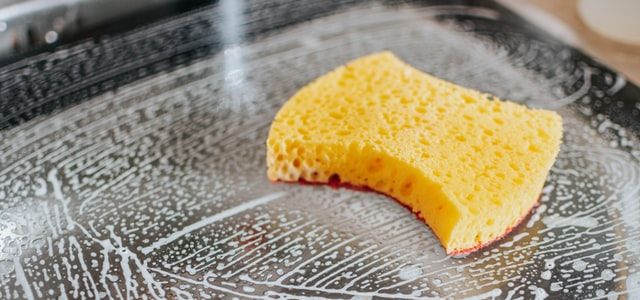The kitchen sponge holds a lot of dirt, and germs. Sponges are an essential part of any kitchen. A kitchen sponge is designed to be absorbent. When bacteria grow on the sponge then it becomes unsafe for use. It is for this reason that we need to know the benefits of maintaining your kitchen sponges and how often should you change a kitchen sponge.
Kitchen sponges are ideal for general household cleaning and polishing tasks, but only if they are not allowed to become dirty. Moisture, soap and food particles that feed the germs during sponge use need to be removed weekly. The frequency of sponge changes is likely to affect kitchen hygiene as well as contribute to kitchen septic tank odor.
Table of Contents
It Depends on How Often You Use Your Sponge
You probably already know that you should clean your kitchen sponge often. After all, it’s the dirtiest item in your house, and every time you use it, you’re just transferring germs from one surface to another. It might surprise you, though, how often you should really be replacing your sponge or at least microwaving it for a minute.
The answer is: It depends on how often you use your sponge. If you’re using it more than three times a day, then you should be microwaving it once a day or tossing it in the dishwasher if that’s an option. Otherwise, once a week should do the trick.
Consider Switching to Cloth Towels
Because sponges are exposed to so much bacteria, the Center for Disease Control recommends washing and drying them frequently, ideally daily. But this is easier said than done. I don’t know about you but when my sponge gets wet, I just leave it on the sink or in the sink until next time I wash dishes.Cloth towels, on the other hand, can be washed after every use along with your clothes. The CDC states that cloth towels are more sanitary than sponges because they can be washed at a high temperature of 140 degrees Fahrenheit (60 degrees Celsius), which is also recommended to prevent food-borne illnesses.
Change It More If You Have Pets
The NSF suggests changing your kitchen sponge every two weeks, if not sooner. You can also zap it in the microwave to kill some of the germs and extend its life for a few more days.If you have pets in the house, you might want to consider changing it more often. Pet waste on your floors and counters can contaminate your sponge faster than normal wear and tear alone could do.
Substitute a Paper Towel for Hard-to-Clean Messes
If you use a sponge to clean up messes on your counters, stop. A paper towel is actually better for cleaning countertops, says Melissa Homer, chief cleaning officer at Maid Brigade. The abrasive surface of the paper towel can scrub away stains and debris more effectively than a sponge can. Plus, if you’re using the same sponge to wipe down your counters as you are to clean dishes and put in the dishwasher, there’s a chance you’re transferring bacteria onto your counters each time you wipe them down.
If you use a sponge to clean up messes on your countertops, stop. A paper towel is actually better for cleaning countertops, says Melissa Homer, chief cleaning officer at Maid Brigade. The abrasive surface of the paper towel can scrub away stains and debris more effectively than a sponge can. Plus, if you’re using the same sponge to wipe down your counters as you are to clean dishes and put in the dishwasher, there’s a chance you’re transferring bacteria onto your counters each time you wipe them down.
Swap a Brush for Tough Scrubbing
When you scrub dishes or countertops with a sponge, you’re probably using a product that’s crawling with bacteria. In fact, the kitchen sponge can be one of the germiest items in your house.But there are some tricks you can use to make sponges last longer, and there are other ways to clean without them. Here are some tips for keeping things clean and germ-free.
First, squeeze out excess water after use and let the sponge dry out completely before using it again. A damp sponge is more attractive to bacteria than a dry one, says Kelly A. Reynolds, PhD, an associate professor at the University of Arizona Mel and Enid Zuckerman College of Public Health in Tucson.
Nuke Your Sponge in the Microwave
To clean your sponge, the best thing to do is to nuke it in the microwave. Just wet the sponge, squeeze out the excess water and place it in the microwave for 30 seconds. If your sponge has a built-in scrubber or if there’s food stuck in it, add one minute to that cooking time.This may seem counterintuitive, but microwaving a damp sponge kills 99.999 percent of bacteria and germs.
The key here is making sure your sponge is wet, you should never microwave a dry sponge.If you don’t have a microwave, you can also sanitize your sponges by boiling them on the stovetop for up to 10 minutes or soaking them in diluted bleach solution.
Conclusion
In the end, your kitchen sponge should be changed out every one to three weeks, or if it begins to smell. With proper care and cleaning, your sponge can last longer, which of course means that you will have to change it less. Sponges are relatively inexpensive, so don’t hesitate to change yours out as often as necessary.
Our kitchen sponges are already the most often-used utensils in your household, and chances are you don’t think about them too much. But there is a right way to do it. If you change your kitchen sponge when it begins to stink, you help prevent both your kitchen surfaces and your body from being exposed to harmful germs that can be lurking on a dirty sponge.


